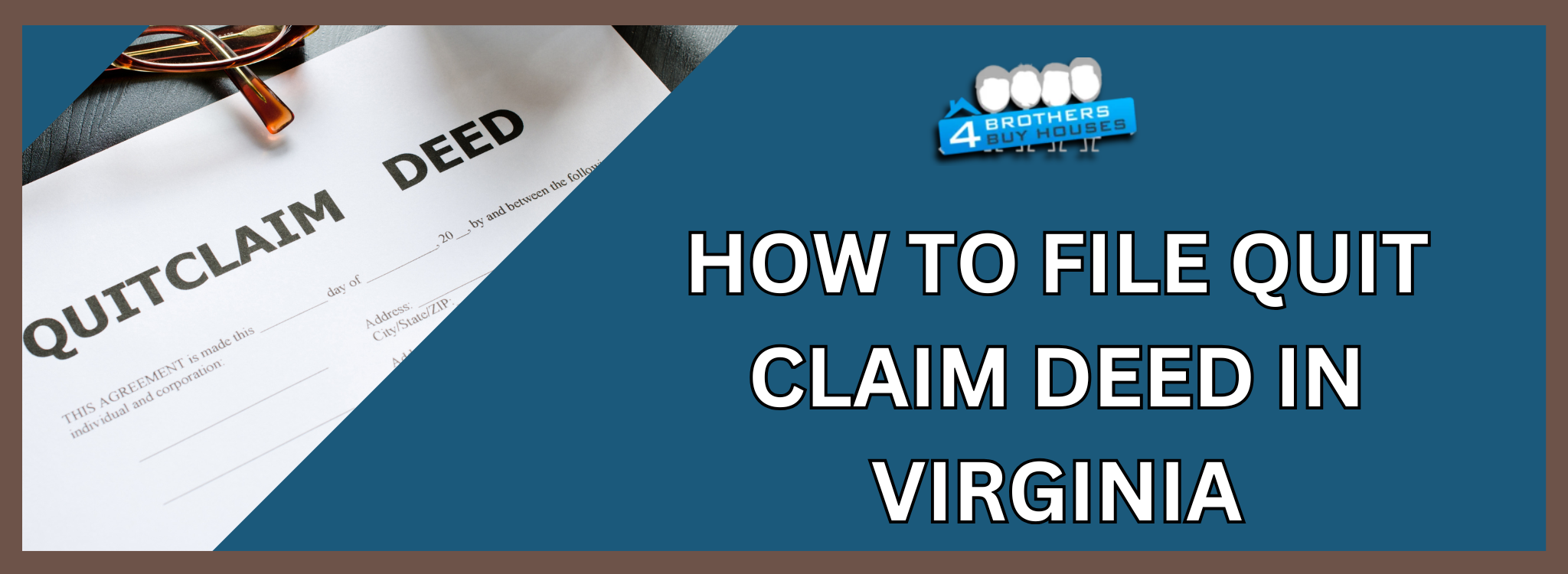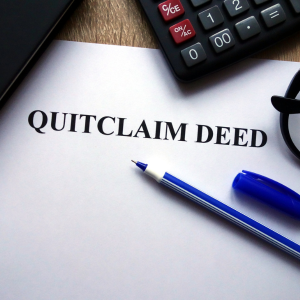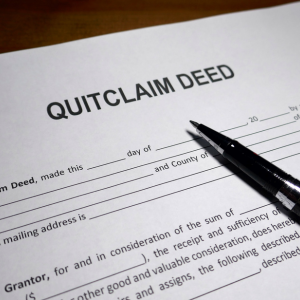
Components of a Quitclaim Deed in Virginia
What Information Should Be Included in a Quit Claim Deed?
A quitclaim deed in Virginia is a legal instrument that transfers property ownership from the grantor to the grantee. To comply with Virginia law and ensure accurate transfer, the deed must include the following:
- Grantor and Grantee Details: Include both parties’ full names and addresses.
- Property Description: Provide a clear description of the property, often using its legal description.
- Consideration: State what the grantee gives in exchange for the property. In family transfers, this might simply be “for love and affection.”
- Signatures: The grantor must sign the deed and have it notarized to be legally valid in Virginia.
- Date of Execution: Record the date when the deed is signed.
These elements ensure the deed meets all legal requirements and properly transfers property ownership.
How Is the Virginia Quit Claim Deed Different From Other States?

The Virginia quit claim deed has unique characteristics that set it apart from those used in other states. These differences are vital for anyone involved in real estate transfers in Virginia:
- State-Specific Regulations: Virginia requires specific steps for executing and recording quitclaim deeds, which differ from those in other states.
- Recording Requirements: To notify the public of the transaction, a quit claim deed in Virginia must be recorded at the county clerk’s office where the property is located.
- Tax Implications: Virginia does not impose a separate real estate transfer tax on these deeds, although local fees may still apply.
- Statutory Requirements: The Virginia quit claim deed statute specifies the language and content required for the deed to be legally valid.
While the primary purpose of a quit claim deed remains unchanged, Virginia’s property transfer laws necessitate careful attention to detail for compliance and validity.
Processes Involved in Filing a Quit Claim Deed in Virginia
Who Are the Key Parties in the Filing Process?
In the Virginia quit claim deed process, it is critical to understand who is involved in the transfer of property ownership. The grantor is the property owner who wishes to transfer their stake to someone else. The grantee is the individual or entity that will receive the interest. Consult a legal counsel to ensure compliance with Virginia quit claim deed laws.
Where Do I Obtain and Submit the Necessary Forms?
To begin, you need a Virginia quitclaim deed form. These forms are available from online legal document suppliers and your local county website. Complete the form and send it to the Virginia Clerk of Court in the county where the property is located. Please submit it to the county recorder’s office to be documented in the Virginia land records filing system.
What Fees Are Associated With Filing in Virginia?
When submitting a quitclaim deed in Virginia, numerous expenses are involved. Virginia quit claim deed costs include a county-set filing fee. There may be a Virginia deed transfer charge and real estate transfer tax. These costs can vary depending on the value and location of the property. Before submitting your quitclaim deed in Virginia, check with the local recorder’s office to confirm the expenses.
How Can Errors in the Deed Affect Property Transfer?

Errors in a deed, such as a quit claim deed, can cause significant problems in property transfers by delaying or even canceling the transaction. Virginia property transfer regulations require that every detail in a deed be precise. Filing errors, such as incorrect names or property descriptions, can invalidate a deed, affecting real estate transactions and the transfer of property title.
What Are Common Mistakes to Avoid During Filing?
To avoid common mistakes when filing a Virginia quitclaim deed:
- Incorrect Information: Ensure all details, including the grantor’s and grantee’s names, are correct.
- Form Submission Errors: Double-check that all sections are complete and that you use the right forms.
- Property Description: To avoid disputes, provide an exact legal description of the property.
- Grantor and Grantee Names: Enter full legal names accurately without spelling errors.
Following these tips and preparing documents carefully can reduce the chance of problems during the property transfer process.
How Does Virginia Law Address Filing Errors?
Virginia law outlines steps to fix errors in a quitclaim deed filing. The error correction process involves taking specific legal actions:
- Legal Ramifications: Mistakes in filing can lead to issues that must be resolved.
- Corrective Measures: Amend the deed to fix mistakes and submit it again for approval.
- Consult a Legal Advisor: Getting professional advice ensures compliance with Virginia quit claim deed requirements.
Dealing with any errors in a deed promptly helps protect the integrity of the property transfer.
Why Might a Quitclaim Deed Be Rejected in Virginia?

A quitclaim deed in Virginia can be rejected for several reasons:
- Noncompliance with Virginia Law: Not following state-specific rules can invalidate the deed.
- Missing Signatures: All required signatures must be on the deed to be valid.
- Unnotarized Document: Proper notarization is needed before submission.
- Virginia Quit Claim Deed Validity: The court clerk and the recording office will check if the deed meets legal standards.
Steps to Remedy Rejections
If a quitclaim deed is rejected, follow these steps to fix the issue:
- Remedy Rejections: Find and correct any mistakes in the document.
- Consult a Legal Advisor: Professional guidance ensures proper adherence to Virginia guidelines.
- Resubmit Corrected Deed: Follow the legal compliance process carefully.
- Ensure Accuracy: Thoroughly review the document before sending it again to prevent more problems.
Following these steps can help you address rejections and make the property transfer process smoother.
How Does Notarization Impact the Validity of a Quitclaim Deed?
Is Notarization Mandatory for Virginia Quit Claim Deeds?

In Virginia, notarization is required to ensure the legality of a quitclaim deed. A quitclaim deed must be notarized correctly in order to be considered valid under state law. This approach ensures that the agreement adequately reflects the parties’ intentions and helps avoid disputes. Without notarization, the deed may be invalid in legal processes, compromising the legitimacy of the property transfer.
Where Can a Quitclaim Deed Be Notarized in Virginia?
Notarizing a quitclaim deed in Virginia is relatively straightforward. There are many accredited notary services available, including:
- Local banks often provide notary services for their clients.
- Law firms typically offer notarization as part of their services.
- UPS or FedEx stores, many of which have notaries on-site.
- Courthouses may offer notary services or can refer you to nearby accredited notaries.
Choosing a reliable notary service is essential to ensure the accuracy and acceptance of your quitclaim deed.
What Are the Next Steps After Recording a Quit Claim Deed?
Following the registration of a quit claim deed with the local authorities in Virginia, many crucial actions are taken to ensure that the property’s records are current and accurate. After confirmation of recording:
- Obtain Copies: Get certified copies of the recorded deed for yourself and any involved parties.
- Verify Property Records: Contact the county’s property records office to ensure all information reflects the latest changes.
- Inform Interested Parties: Notify parties who need to know the deed changes, such as lenders or insurance companies.
- Update Personal Records: Update your files with the new deed details for future reference.
Completing these steps helps maintain transparency and clarity for everyone involved in the property transaction.
When Is the Use of a Quitclaim Deed Most Appropriate?
In Which Situations Is a Quitclaim Deed Recommended?

A quitclaim deed is a useful legal tool for transferring property ownership without the protections of a warranty deed. It is suitable in certain situations:
- Family Transfers: Ideal when transferring property between family members, such as after marriage or divorce.
- Trusts and LLCs: Used when placing property into a trust or transferring between entities owned by the same individual.
- Clear Title Issues: Effective for resolving title defects by quickly releasing potential claims.
The transfer process requires fewer formalities, making it more efficient in these cases. Understanding the legal requirements ensures that all parties are informed and agree on the transfer.
Are There Alternatives to a Quitclaim Deed in Virginia?
In Virginia, there are alternatives to using a quitclaim deed when more security is needed for the buyer:
- Warranty Deed: This offers a guarantee from the grantor that there are no title issues. It is beneficial in transactions where the buyer needs protection against future claims.
- Special Warranty Deed: Provides limited assurances, covering only the period during which the seller owned the property.
- Bargain and Sale Deed: Rarely used; it implies ownership but offers no protection against claims.
Understanding Virginia property laws is critical when determining the best manner of real estate transfer. Consulting a legal professional can help you comply with state requirements and select the best option.
How Can You Ensure a Smooth Filing Process in Virginia?

Filing a quitclaim deed in Virginia involves key steps to transfer ownership successfully:
- Prepare the Document: Complete the deed accurately, including precise details of both the grantor and grantee and a clear description of the property.
- Sign and Notarize: Have both parties sign the document in the presence of a notary public for validation.
- Submit to the County Recorder: File the deed with the recorder’s office in the county where the property is located. Pay any required fees and taxes.
Following these steps under Virginia law promotes a smooth filing process. Seeking assistance from a real estate attorney can help address potential issues and confirm that all legal requirements are met.
If you have questions or need further guidance on quitclaim deeds and property transfer processes, contact 4 Brothers Buy Houses. Our team provides dedicated support for real estate matters.
FAQs:
What Is A Quitclaim Deed, And How Does It Differ From Other Deeds In Virginia?
A Quit Claim Deed transfers ownership without any warranty. It doesn’t assure the recipient of a clear title or absence of liens. This type of deed is commonly used among family members or to resolve title issues.
How Can I File A Quitclaim Deed In Virginia?
To file a Quit Claim Deed in Virginia, fill out the form, sign it before a notary, and submit it to the local County Clerk’s office along with any fees. Ensure compliance with local laws.
What Should I Consider When Using A Quitclaim Deed In Virginia?
Understand that a Quit Claim Deed doesn’t guarantee ownership status. It’s wise to seek advice from a real estate attorney to understand your legal position.
Can I Electronically Record A Quitclaim Deed In Virginia?
Yes, many counties in Virginia allow electronic recording of deeds. Check with the County Clerk’s office for specific requirements.
Where Can I Find A Sample Quitclaim Deed Form For Virginia?
Sample forms are available online on legal websites. Ensure the form you use complies with Virginia’s regulations.
What Are The Steps Involved In The Quit Claim Process In Virginia?
The process includes completing the deed form, notarizing it, and filing it with the County Clerk’s office. Verify each step with current state guidelines.
Are There Any Disclaimers I Should Be Aware Of When Filing A Quitclaim Deed In Virginia?
A Quit Claim Deed does not assure a clear title, which could expose the grantee to claims. Legal consultation is advised to understand any risks.
How Do I Resolve Issues If There’s A Block In The Transfer Process?
For disputes or incorrect information, consult a real estate attorney to address and legally resolve the issue.
Key Insights
- Our detailed guide covers everything from preparation to electronic recording and teaches you how to file a quitclaim deed in Virginia.
- Understand the process of filing a deed and the specific steps required to file a quitclaim deed in Virginia, including performance and security measures.
- Access clear instructions for completing a quit claim deed in Virginia, along with essential information on the quit claim process and needed documentation.
- To manage the Virginia quit claim deed process smoothly, follow our step-by-step guide and sample quit claim deed.
- Download a sample quit claim deed PDF specific to Virginia, ensuring you have the correct format and content as per state regulations.
- Get instructions for the electronic recording of a quitclaim deed in Virginia, streamlining your submission through efficient methods.
- To avoid common mistakes, pay attention to required details by reviewing detailed instructions on filing a quit claim deed in Virginia.
- If you’re planning to file a quitclaim deed, please review what you need to know about legal compliance and requirements unique to Virginia.
- Our informative blog answers common questions and includes an FAQ section to clarify Virginia’s quit claim deed processes.
- For additional support or queries, contact an expert for guidance on Virginia quit claim deeds or to resolve issues promptly.
Want to know the best way to sell your house in Virginia? We’re here to help! Whether you’re in Arlington, Alexandria, Dale City, Reston, McLean, or any nearby area, our insights apply across the state. We specialize in making the selling process smooth and hassle-free, and if you’re looking for a quick sale, we buy houses too! Learn more about your options. For expert guidance and a stress-free experience, Contact Us at 202-601-4928 .


